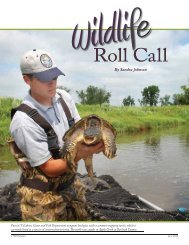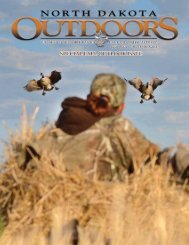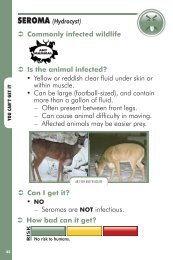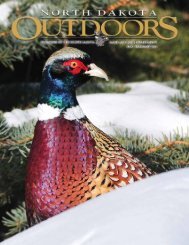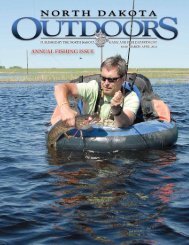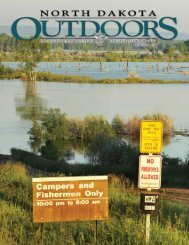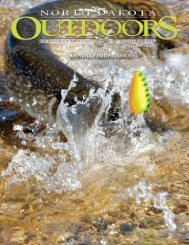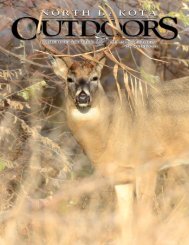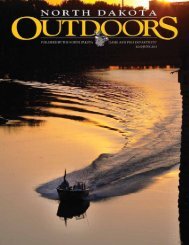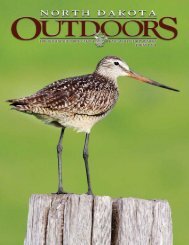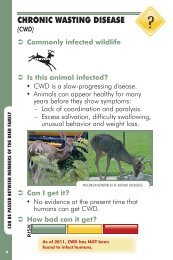Fish of North Dakota Brochure - North Dakota Game and Fish
Fish of North Dakota Brochure - North Dakota Game and Fish
Fish of North Dakota Brochure - North Dakota Game and Fish
Create successful ePaper yourself
Turn your PDF publications into a flip-book with our unique Google optimized e-Paper software.
NORTH DAKOTA GAME AND FISH DEPARTMENT
TABLE OF CONTENTS<br />
PIKE FAMILY<br />
<strong>North</strong>ern Pike ...............................................................................................................1<br />
Muskellunge ................................................................................................................2<br />
PERCH FAMILY<br />
Walleye .......................................................................................................................3<br />
Sauger ........................................................................................................................4<br />
Yellow Perch .................................................................................................................5<br />
Johnny Darter ..............................................................................................................6<br />
SUNFISH FAMILY<br />
Largemouth Bass ..........................................................................................................7<br />
Smallmouth Bass ..........................................................................................................8<br />
Bluegill ........................................................................................................................9<br />
Orange-Spotted Sunfish ..............................................................................................10<br />
Pumpkinseed ..............................................................................................................11<br />
Green Sunfish ............................................................................................................12<br />
Black Crappie ............................................................................................................13<br />
White Crappie ............................................................................................................14<br />
TEMPERATE OR TRUE BASS FAMILY<br />
White Bass .................................................................................................................15<br />
DRUM FAMILY<br />
Freshwater Drum ........................................................................................................16<br />
CATFISH FAMILY<br />
Channel Catfish .........................................................................................................17<br />
Black Bullhead ...........................................................................................................18<br />
PADDLEFISH FAMILY<br />
Paddlefish ..................................................................................................................19<br />
GAR FAMILY<br />
Shortnose Gar ............................................................................................................20<br />
STURGEON FAMILY<br />
Shovelnose Sturgeon ..................................................................................................21<br />
TROUT FAMILY<br />
Rainbow Trout ............................................................................................................22<br />
Brown Trout................................................................................................................23<br />
Chinook Salmon ........................................................................................................24<br />
COD FAMILY<br />
Burbot .......................................................................................................................25<br />
MOONEYE FAMILY<br />
Goldeye ....................................................................................................................26<br />
SUCKER FAMILY<br />
White Sucker ..............................................................................................................27<br />
Bigmouth Buffalo ........................................................................................................28<br />
Quillback Carpsucker .................................................................................................29<br />
Shorthead Redhorse ....................................................................................................30<br />
MINNOW FAMILY<br />
Carp .........................................................................................................................31<br />
Fathead Minnow ........................................................................................................32<br />
Golden Shiner ............................................................................................................33<br />
Creek Chub ...............................................................................................................34<br />
STICKLEBACK FAMILY<br />
Brook Stickleback .......................................................................................................35<br />
SMELT FAMILY<br />
Rainbow Smelt ...........................................................................................................36
<strong>North</strong>ern Pike<br />
PIKE FAMILY<br />
There are two members <strong>of</strong> the pike family in <strong>North</strong> <strong>Dakota</strong>,<br />
the northern pike <strong>and</strong> muskellunge. Both have long bodies<br />
<strong>and</strong> long snouts with large teeth. The dorsal fin is located far<br />
back on the body.<br />
Pike are marked with horizontal body spots <strong>and</strong> never have more<br />
than five pores on each side <strong>of</strong> the lower jaw. Pike have scales covering<br />
their entire cheek. The northern pike was named <strong>North</strong> <strong>Dakota</strong>’s state<br />
fish in 1969.<br />
Pike feed on a wide variety <strong>of</strong> foods including other fish, aquatic<br />
insects, salam<strong>and</strong>ers, frogs <strong>and</strong> even baby ducks. They are excellent<br />
fighters <strong>and</strong> one <strong>of</strong> <strong>North</strong> <strong>Dakota</strong>’s best-tasting fish. Pike <strong>of</strong>ten get a<br />
bad ‘rap’, because <strong>of</strong> their protective slime coating. Many interesting<br />
names have been given to pike including snake, slough shark, jack,<br />
hog <strong>and</strong> snot rocket.<br />
1
2<br />
PIKE FAMILY<br />
Muskellunge<br />
Muskellunge have vertical dark bars on their sides <strong>and</strong> 6-8<br />
pores on each side <strong>of</strong> the lower jaw. They have scales only on the<br />
upper half <strong>of</strong> the cheek. The tiger musky is a hybrid cross between a<br />
female muskellunge <strong>and</strong> a male northern pike.<br />
Musky are found in a select few <strong>North</strong> <strong>Dakota</strong> waters.
Walleye<br />
PERCH FAMILY<br />
Members <strong>of</strong> the perch family have two completely separated<br />
dorsal fins. The first fin is spiny while the second fin has s<strong>of</strong>t<br />
rays. Walleye, sauger <strong>and</strong> yellow perch are popular members<br />
<strong>of</strong> this family. Darters, which seldom exceed 4 inches,<br />
also belong to the perch family.<br />
Walleye are a dark-olive color with an overall golden brown mottling<br />
<strong>and</strong> a white belly. A black blotch on the lower rear portion <strong>of</strong> the<br />
front dorsal fin helps identify this fish. Walleye prefer s<strong>and</strong> <strong>and</strong> gravel<br />
bottom areas, habitat commonly found in our large reservoirs.<br />
Stocked fish also do fairly well in some small lakes in <strong>North</strong><br />
<strong>Dakota</strong>.<br />
3
4<br />
PERCH FAMILY<br />
Sauger<br />
Sauger are a native fish that resemble walleye, but are usually<br />
thinner in build. They have a blotched body color <strong>and</strong> rows <strong>of</strong> dark<br />
spots on the dorsal fin instead <strong>of</strong> the one black blotch <strong>of</strong> the walleye.<br />
Sauger typically inhabit fairly fast moving water <strong>of</strong> rivers <strong>and</strong><br />
streams. The saugeye is a cross between a walleye <strong>and</strong> sauger but<br />
cannot be positively identified by external physical characteristics.
Yellow Perch<br />
PERCH FAMILY<br />
Yellow-green in color, yellow perch have 6-8 dark bars running<br />
up <strong>and</strong> down their sides. They have two spines <strong>and</strong> 6-8 s<strong>of</strong>t rays in the<br />
anal fin while walleye <strong>and</strong> sauger have two spines <strong>and</strong> 11-14 s<strong>of</strong>t rays<br />
in the anal fin, which helps identify them when small.<br />
Perch can be easy to catch <strong>and</strong> are quality eating.<br />
5
6<br />
PERCH FAMILY<br />
Johnny Darter<br />
The Johnny Darter is one <strong>of</strong> several species <strong>of</strong> darters found in<br />
<strong>North</strong> <strong>Dakota</strong>. It can be identified by the series <strong>of</strong> black “w” or “x”<br />
shapes scattered across its sides.<br />
Darters live in swift moving streams <strong>and</strong> apparently are not<br />
important prey for larger fish because <strong>of</strong> their small size <strong>and</strong> habit <strong>of</strong><br />
hiding under rocks <strong>and</strong> in crevices.<br />
Adults are typically 1.5 to 2.5 inches long. They feed on small<br />
aquatic insect larvae.
Largemouth Bass<br />
SUNFISH FAMILY<br />
Sunfish family members are deep <strong>and</strong> stockily built, attractive<br />
in coloration, <strong>and</strong> popular as pan fish. Their dorsal fin<br />
has a spiny front portion <strong>and</strong> a s<strong>of</strong>t rayed rear portion. The<br />
dorsal fin is almost separated into two parts in the large<br />
<strong>and</strong> smallmouth basses.<br />
The back <strong>and</strong> upper sides <strong>of</strong> the largemouth are a dark green<br />
color <strong>and</strong> its sides have dark irregular patches. As its name implies,<br />
the mouth is large with the end <strong>of</strong> the upper jaw extending to or<br />
beyond the rear margin <strong>of</strong> the eye. It prefers small lake habitat. Its<br />
eyes are golden.<br />
Largemouth bass are more common in southern states where<br />
water is warmer throughout the year. They are excellent fighters on<br />
hook <strong>and</strong> line.<br />
7
8<br />
SUNFISH FAMILY<br />
Smallmouth Bass<br />
The smallmouth is similar in color to the largemouth except for<br />
barred markings on its sides <strong>and</strong> red eyes. The mouth is smaller <strong>and</strong><br />
the rear <strong>of</strong> the upper jaw does not extend beyond the center <strong>of</strong> the<br />
eye. It prefers habitat similar to walleye.<br />
Smallmouth bass are an under-utilized resource in <strong>North</strong> <strong>Dakota</strong><br />
<strong>and</strong> provide an excellent fight on hook <strong>and</strong> line.
Bluegill<br />
SUNFISH FAMILY<br />
This wonderful <strong>and</strong> scrappy little fish varies in coloration, but usually<br />
is dark olive above with dark vertical bars on the upper sides <strong>and</strong><br />
orange or yellow on the throat <strong>and</strong> belly. Its gill covers are blue with a<br />
black tip on the flap.<br />
It is probably the most popular member <strong>of</strong> the sunfish family in<br />
<strong>North</strong> <strong>Dakota</strong>, however, at times it may be stunted due to overpopulation.<br />
It is <strong>of</strong>ten called sunfish or sunny.<br />
9
10<br />
SUNFISH FAMILY<br />
Orange-Spotted Sunfish<br />
The orange-spotted sunfish is similar to the bluegill but usually<br />
more colorful <strong>and</strong> smaller in size. Adult fish are only three to four<br />
inches in length.<br />
It has a black tab on its gill cover that is edged in white. It is not<br />
common in <strong>North</strong> <strong>Dakota</strong> since its primary habitat is medium to large<br />
rivers such as the Missouri River.<br />
These fish are seldom caught by anglers <strong>and</strong> therefore are not<br />
observed by many people.
Pumpkinseed<br />
SUNFISH FAMILY<br />
Similar to the bluegill, but lighter in color <strong>and</strong> usually not as<br />
large. It has a red or orange spot on the flap <strong>of</strong> the gill cover. It may<br />
hybridize with bluegill <strong>and</strong> is not abundant in <strong>North</strong> <strong>Dakota</strong>.<br />
11
12<br />
SUNFISH FAMILY<br />
Green Sunfish<br />
The green sunfish is small, hardy <strong>and</strong> <strong>of</strong>ten over-populates our<br />
waters. It also resembles a bluegill, but has a much larger mouth <strong>and</strong><br />
a black tip on the gill cover, edged in a lighter color. Quite common in<br />
southwestern <strong>North</strong> <strong>Dakota</strong>, it is seldom important as a sport fish.
Black Crappie<br />
SUNFISH FAMILY<br />
Flat <strong>and</strong> silvery <strong>and</strong> marked with irregular dark spots, the crappie<br />
is an attractive <strong>and</strong> desirable fish. The black crappie is positively<br />
identified by its 7-8 spines in the dorsal fin.<br />
It prefers clear water conditions <strong>and</strong> feeds primarily on small fish<br />
as an adult.<br />
13
14<br />
SUNFISH FAMILY<br />
White Crappie<br />
Looks similar to the black crappie, but only has 5-6 spines in the<br />
dorsal fin. The dark spots on its sides are consolidated into vertical<br />
bars. The white crappie is more tolerant <strong>of</strong> turbid water <strong>and</strong> well-suited<br />
to reservoirs such as Lake Tschida <strong>and</strong> Patterson Lake.
White Bass<br />
TEMPERATE OR<br />
TRUE BASS FAMILY<br />
The introduced white bass is the only member <strong>of</strong> this family<br />
in <strong>North</strong> <strong>Dakota</strong>. The dorsal fin <strong>of</strong> the bass family is separated,<br />
not joined as in the sunfish family.<br />
This beautiful silver-gray fish has rows <strong>of</strong> dark narrow stripes running<br />
the length <strong>of</strong> its body. At times it reproduces abundantly <strong>and</strong> then<br />
the population seems to almost vanish until conditions favor it. It has<br />
done well in our large lakes <strong>and</strong> reservoirs such as Devils Lake <strong>and</strong><br />
Lake Oahe. Some call this fish a silver bass.<br />
15
16<br />
DRUM FAMILY<br />
This family contains many saltwater fishes, but only one that<br />
lives entirely in freshwater. Some drum species have complicated<br />
swim bladders <strong>and</strong> make audible sounds, especially<br />
during spawning season.<br />
Freshwater Drum<br />
Also known as sheepshead <strong>and</strong> grunter, it is silver-gray <strong>and</strong><br />
deep-bodied. The top fin is long <strong>and</strong> almost separated into two parts.<br />
The tail is rounded. It has two “lucky stones” or ear bones located in<br />
its head. These stones are correctly termed otoliths <strong>and</strong> are used by<br />
the fish for balance, orientation <strong>and</strong> sound detection. All fish have<br />
these structures but they are more pronounced in drum.<br />
The drum feeds on the bottom in calm areas <strong>of</strong> deep rivers <strong>and</strong><br />
lakes. At first glance, this fish can be confused with a white bass.<br />
Drum are excellent to eat after removing the thin layer <strong>of</strong> red, fatty<br />
meat on the skin side <strong>of</strong> the flesh.
Channel Catfish<br />
CATFISH FAMILY<br />
Catfish family members range from small to large fish, do<br />
not have scales, <strong>and</strong> possess several pairs <strong>of</strong> whisker-like<br />
barbels. They also have wide heads <strong>and</strong> broad mouths.<br />
The channel catfish is our most widespread member <strong>of</strong> the catfish<br />
family. It has a deeply forked tail, is a grayish brown color, <strong>and</strong> sports<br />
an anal fin with 24-29 rays. Small channel cats <strong>of</strong>ten have small black<br />
body spots. It prefers large rivers <strong>and</strong> lakes as its habitat.<br />
The Red River, Missouri River <strong>and</strong> Lake Oahe are excellent catfishing<br />
locations. Catfish are an under-utililzed resource in the state<br />
<strong>and</strong> are excellent eating.<br />
17
18<br />
CATFISH FAMILY<br />
Black Bullhead<br />
The black bullhead is our most common bullhead. Compared<br />
to a catfish, bullheads are stockier, darker in color, have a more<br />
rounded, slightly notched tail, <strong>and</strong> are not as large. <strong>North</strong> <strong>Dakota</strong><br />
also has yellow <strong>and</strong> brown bullheads. The black bullhead has 17-20<br />
rays in the anal fin. There are also variations in color in the three<br />
bullhead species as the names suggest, but not as noticeable as might<br />
be expected.
Paddlefish<br />
PADDLEFISH FAMILY<br />
There is only one member <strong>of</strong> the paddlefish family in <strong>North</strong><br />
<strong>Dakota</strong> <strong>and</strong> it is easily recognized by its long, paddle-like<br />
snout.<br />
Almost shark-like in appearance, paddlefish do not have bones.<br />
Its only scales are located on the upper lobe <strong>of</strong> the tail <strong>and</strong> its gill<br />
covers are very long. It is a large <strong>and</strong> long-lived fish that feeds on<br />
plankton so it seldom is taken on lures or baits. Snagging is the<br />
accepted method <strong>of</strong> taking paddlefish. This prehistoric fish is closely<br />
managed to avoid overharvest. Paddlefish have an established<br />
spawning run upstream from Lake Sakakawea into the Missouri <strong>and</strong><br />
Yellowstone rivers. Also called spoonbill catfish <strong>and</strong> shovelnose cat,<br />
these unique fish commonly grow to 100 pounds.<br />
19
20<br />
GAR FAMILY<br />
Shortnose Gar<br />
Gar are primitive fish, <strong>of</strong>ten referred to as living fossils. Their<br />
long bodies are reminiscent <strong>of</strong> pike when seen near the<br />
surface <strong>of</strong> a quiet Missouri River backwater. Gar have hard,<br />
diamond-shaped scales <strong>and</strong> their long thin jaws have many<br />
short, sharp teeth.<br />
This tough, bony fish is seldom taken by anglers, but occasionally<br />
by people bowfishing when they find them sunning near the surface.<br />
Long <strong>and</strong> slim, it grows to about a 30-inch maximum length. It is<br />
armor-plated, large toothed <strong>and</strong> is an interesting fish that was probably<br />
more abundant before the large Missouri River dams were built.
Sturgeons are primitive fish with a cartilaginous skeleton,<br />
shovel-like snout, four barbels under the snout in front <strong>of</strong><br />
a toothless mouth, long shark-like tail, <strong>and</strong> bony plates or<br />
scales on the body. They are found in the Missouri River<br />
system.<br />
Shovelnose Sturgeon<br />
STURGEON FAMILY<br />
The shovelnose sturgeon, which seldom exceeds 5 pounds, is our<br />
most abundant sturgeon. It is recognized by scales on its belly, short<br />
snout <strong>and</strong> barbels located in front <strong>of</strong> the mouth. The two center barbels<br />
are almost as long as the outside barbels. The pallid sturgeon, an<br />
endangered species, is the largest sturgeon in <strong>North</strong> <strong>Dakota</strong>, weighing<br />
up to 80 pounds. It has been on a decline in the Missouri River system<br />
probably due to habitat changes caused by the construction <strong>of</strong> large<br />
dams. Law now requires that all sturgeon must be released immediately<br />
to protect the larger pallid which look a lot like the shovelnose at<br />
a young age. Pallid sturgeon lack scales on the belly. The two center<br />
barbels are only about half as long <strong>and</strong> are located slightly in front <strong>of</strong><br />
the outside barbels.<br />
21
22<br />
TROUT FAMILY<br />
Rainbow Trout<br />
In <strong>North</strong> <strong>Dakota</strong>, members <strong>of</strong> the trout family are all introduced.<br />
Trout are beautiful fish, sporty to catch, <strong>and</strong> fine eating.<br />
<strong>North</strong> <strong>Dakota</strong> habitat does not provide the conditions<br />
for most trout to spawn <strong>and</strong> reproduce successfully. They<br />
must be grown in a hatchery <strong>and</strong> then stocked into area<br />
lakes.<br />
The rainbow trout from the Pacific Coast has been widely stocked<br />
in <strong>North</strong> <strong>Dakota</strong> <strong>and</strong> has been the most successful. It varies in coloring,<br />
but usually has pinkish streaks on its sides <strong>and</strong> small black spots<br />
on its sides, fins <strong>and</strong> tail. The rainbow has 9-12 rays in its anal fin.<br />
Rainbows prefer colder water temperatures. They grow very well<br />
in the Missouri River system but have also done surprisingly well in<br />
some smaller lakes. Trout are powerful fighters.
Brown Trout<br />
TROUT FAMILY<br />
The brown or German trout is native to Europe <strong>and</strong> should be<br />
able to survive under warmer water conditions than the rainbow. It is<br />
found in the Missouri River system <strong>and</strong> a few lakes where it is regularly<br />
stocked. Like the rainbow, it has 9-12 rays in the anal fin. It has spots<br />
that are much larger <strong>and</strong> more colorful than those <strong>of</strong> the rainbow.<br />
The spots on the brown trout may be black, brown, orange or red<br />
<strong>and</strong> surrounded with a light halo. On large browns, the spots may be<br />
irregular shaped or even x-shaped. The brown usually does not have<br />
spots on its tail.<br />
23
24<br />
TROUT FAMILY<br />
Chinook Salmon<br />
Chinooks, also called king salmon, are stocked in the Missouri<br />
River system <strong>and</strong> provide fishermen with a great fight on hook <strong>and</strong> line.<br />
The inside <strong>of</strong> the lower jaw <strong>of</strong> a chinook is blackish in color, while in<br />
rainbows <strong>and</strong> browns, it is white. They are spotted similar to a rainbow.<br />
Chinooks have a long anal fin that contains 15-17 rays. In the late fall<br />
when they reach spawning conditions, they darken in color <strong>and</strong> gradually<br />
deteriorate until death. Chinooks thus vary from silvery to black<br />
in color. <strong>North</strong> <strong>Dakota</strong> conditions prevent chinooks from reproducing<br />
successfully. They are the largest trout found in <strong>North</strong> <strong>Dakota</strong>.
Burbot<br />
COD FAMILY<br />
Almost eel-like in appearance, with a small head <strong>and</strong> small<br />
eyes, it is considered the only member <strong>of</strong> the codfish family<br />
in our waters.<br />
The burbot is a beautifully-colored fish with a single barbel under<br />
its chin, rounded tail <strong>and</strong> long spineless anal <strong>and</strong> dorsal fins.<br />
Also known as a ling, burbot are great predators <strong>and</strong> therefore<br />
can be caught on a variety <strong>of</strong> tackle. Likely because <strong>of</strong> their snakelike<br />
appearance, they have been killed <strong>and</strong> discarded by anglers for no<br />
reason. Burbot are excellent eating.<br />
25
26<br />
MOONEYE FAMILY<br />
Goldeye<br />
Members <strong>of</strong> this family are flat-sided <strong>and</strong> silvery, largescaled,<br />
<strong>and</strong> have well developed teeth.<br />
Goldeye are found in both the Red River <strong>and</strong> Missouri River<br />
systems. The goldeye is described as flat-sided <strong>and</strong> silvery with a large<br />
golden eye <strong>and</strong> only one dorsal fin located almost directly above the<br />
anal fin. It is <strong>of</strong>ten called skipjack or shiner. It is important as a forage<br />
fish for predators like salmon <strong>and</strong> pike. They are bony fish, best<br />
prepared for eating by smoking.
White Sucker<br />
SUCKER FAMILY<br />
Suckers are native fish <strong>and</strong> as their name implies, have<br />
sucker-like mouths with large lips <strong>and</strong> no teeth. They are<br />
suited to feed on the bottom <strong>and</strong> serve as forage for other<br />
fish.<br />
Like other members <strong>of</strong> the sucker family, the white sucker has<br />
no spines in its fins. It has a large number <strong>of</strong> small scales <strong>and</strong> ranges<br />
from a dark color above to a light color below, being darker in color<br />
during the spawning season. It is found in both rivers <strong>and</strong> lakes <strong>and</strong><br />
may be taken by anglers who fish with worms on the bottom.<br />
Like carp, suckers may become over abundant in lakes <strong>and</strong><br />
must be managed to allow room for other more desirable fish to live.<br />
It is not legal to use young suckers in most <strong>North</strong> <strong>Dakota</strong> waters as<br />
baitfish. This management technique is used to prevent introduction<br />
<strong>and</strong> over-population <strong>of</strong> suckers in area waters.<br />
27
Quillback Carpsucker<br />
SUCKER FAMILY<br />
Quillback are white or silvery <strong>and</strong> are best known for long rays<br />
in the front <strong>of</strong> the dorsal fin. It is also known as silver carp <strong>and</strong> <strong>of</strong>ten<br />
confused with the river carpsucker. The blue sucker, another member<br />
<strong>of</strong> the sucker family found in the Missouri River, is larger than most<br />
suckers <strong>and</strong> has a small, pointed head <strong>and</strong> a long dorsal fin.<br />
It is quite uncommon.<br />
29
30<br />
SUCKER FAMILY<br />
Shorthead Redhorse<br />
This redhorse is generally found in rivers. Its silvery color <strong>and</strong><br />
reddish or orange fins make it an attractive fish. However, few anglers<br />
fish for it.
Carp<br />
MINNOW FAMILY<br />
This family comprises the largest number <strong>of</strong> fish in <strong>North</strong><br />
<strong>Dakota</strong>. Nonnative carp <strong>and</strong> about 30 other species <strong>of</strong><br />
small fish are found in <strong>North</strong> <strong>Dakota</strong>. These small minnows<br />
all have a single dorsal fin. They can be an important<br />
source <strong>of</strong> food for other fish as well as birds <strong>and</strong> mammals.<br />
However, they also damage aquatic habitats.<br />
Introduced German carp have multiplied <strong>and</strong> occupy most <strong>North</strong><br />
<strong>Dakota</strong> waters. Carp root up vegetation <strong>and</strong> contribute to turbid water<br />
conditions detrimental to game fish <strong>and</strong> waterfowl. Carp have two<br />
barbels on each side <strong>of</strong> the jaw. Goldfish that are released into the<br />
wild will grow large <strong>and</strong> cause the same problems as carp.<br />
31
32<br />
MINNOW FAMILY<br />
Fathead Minnow<br />
This abundant minnow is important as a bait fish. Males have<br />
black heads <strong>and</strong> horn-like projections across the snout during the<br />
spawning period <strong>and</strong>, are therefore, sometimes referred to as blackhead<br />
minnows.<br />
Fatheads grow to a length <strong>of</strong> 1.5 to 3.5 inches. They eat aquatic<br />
vegetation <strong>and</strong> move in large schools.
Golden Shiner<br />
MINNOW FAMILY<br />
The golden shiner may grow to 12 inches, is hardy <strong>and</strong> can survive<br />
where few fish can. It <strong>of</strong>ten over-populates small fishing lakes. It is illegal<br />
to sell golden shiners as bait fish. It is deep-bodied <strong>and</strong> an attractive<br />
golden color.<br />
33
34<br />
MINNOW FAMILY<br />
Creek Chub<br />
This chub may grow to 12 inches <strong>and</strong> is found mainly in rivers<br />
<strong>and</strong> large streams. Some people like to fish for them <strong>and</strong> others use<br />
them as bait fish.
STICKLEBACK FAMILY<br />
Sticklebacks are hardy little fish with very noticeable spines<br />
on the dorsal area <strong>of</strong> the back.<br />
Brook Stickleback<br />
Rarely exceeding 3 inches, it survives in shallow streams where<br />
few fish can live. The five prominent spines protruding from its back<br />
make it easy to recognize. They may be mixed in with bait minnows so<br />
anglers may first become acquainted with the stickleback in their minnow<br />
buckets.<br />
35
36<br />
SMELT FAMILY<br />
Rainbow Smelt<br />
A marine family that contains 10 species <strong>of</strong> small fish. Some<br />
live in estuaries <strong>and</strong> others are anadromous, entering rivers<br />
<strong>and</strong> streams to spawn.<br />
Smelt are slender, silvery fish with a large mouth <strong>and</strong> well developed<br />
teeth <strong>and</strong> adipose fin. First stocked in Lake Sakakawea in 1971,<br />
smelt have multiplied <strong>and</strong> spread throughout the Missouri River system.<br />
They are an important source <strong>of</strong> food for salmon, walleye <strong>and</strong><br />
other Lake Sakakawea fish. Large smelt may be 12 inches in length but<br />
most adults are generally 7-9 inches. Few live beyond 5 years <strong>of</strong> age.
<strong>Game</strong> <strong>and</strong> <strong>Fish</strong><br />
Department<br />
Headquarters Office:<br />
100 N. Bismarck Expy.<br />
Bismarck, ND 58501<br />
(701) 328-6300<br />
Devils Lake Office:<br />
7928 45th St. NE<br />
Devils Lake, ND 58301<br />
(701) 662-3617<br />
Dickinson Office:<br />
225 30th Ave. SW<br />
Dickinson, ND 58601<br />
(701) 227-7431<br />
Lonetree WMA:<br />
Headquarters<br />
1851 23rd Ave. NE<br />
Harvey, ND 58341<br />
(701) 324-2211<br />
Riverdale Office:<br />
406 <strong>Dakota</strong> Ave.<br />
Riverdale, ND 58565<br />
(701) 654-7475<br />
Jamestown Office:<br />
3320 E. Lakeside Rd.<br />
Jamestown, ND 58402<br />
(701) 253-6480<br />
Williston Office<br />
13932 W. Front St.<br />
Williston, ND 58801<br />
(701) 774-4320<br />
gf.nd.gov<br />
e-mail: ndgf@nd.gov<br />
NORTH DAKOTA GAME AND FISH DEPARTMENT<br />
The NDGFD receives Federal financial assistance from the US <strong>Fish</strong> <strong>and</strong> Wildlife Service. In accordance with Title VI <strong>of</strong> the Civil<br />
Rights Act <strong>of</strong> 1964, Section 504 <strong>of</strong> the Rehabilitation Act <strong>of</strong> 1973, Title II <strong>of</strong> the Americans with Disabilities Act <strong>of</strong> 1990, the Age<br />
Discrimination Act <strong>of</strong> 1975, <strong>and</strong> Title IX <strong>of</strong> the Education Amendments <strong>of</strong> 1972, the NDGFD joins the US Department <strong>of</strong> the<br />
Interior <strong>and</strong> its Bureaus in prohibiting discrimination on the basis <strong>of</strong> race, color, national origin, age, disability, sex (in education<br />
programs or activities) <strong>and</strong> also religion for the NDGFD. If you believe you have been discriminated against in any program,<br />
activity, or facility as described above, or you desire further information, please write to: ND <strong>Game</strong> <strong>and</strong> <strong>Fish</strong> Department, Attn:<br />
Chief Administrative Services, 100 N. Bismarck Expressway, Bismarck, ND 58501-5095 or to: U.S. <strong>Fish</strong> <strong>and</strong> Wildlife Service,<br />
Attn: Civil Rights Coordinator, 4401 N. Fairfax Drive, Mail Stop: MBSP-4020, Arlington, Virginia 22203. The TTY/TTD (Relay<br />
ND) number for the hearing or speech impaired is 1-800-366-6888.



